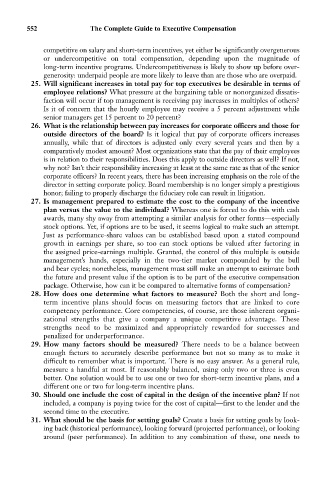Page 566 - Bruce Ellig - The Complete Guide to Executive Compensation (2007)
P. 566
552 The Complete Guide to Executive Compensation
competitive on salary and short-term incentives, yet either be significantly overgenerous
or undercompetitive on total compensation, depending upon the magnitude of
long-term incentive programs. Undercompetitiveness is likely to show up before over-
generosity: underpaid people are more likely to leave than are those who are overpaid.
25. Will significant increases in total pay for top executives be desirable in terms of
employee relations? What pressure at the bargaining table or nonorganized dissatis-
faction will occur if top management is receiving pay increases in multiples of others?
Is it of concern that the hourly employee may receive a 5 percent adjustment while
senior managers get 15 percent to 20 percent?
26. What is the relationship between pay increases for corporate officers and those for
outside directors of the board? Is it logical that pay of corporate officers increases
annually, while that of directors is adjusted only every several years and then by a
comparatively modest amount? Most organizations state that the pay of their employees
is in relation to their responsibilities. Does this apply to outside directors as well? If not,
why not? Isn’t their responsibility increasing at least at the same rate as that of the senior
corporate officers? In recent years, there has been increasing emphasis on the role of the
director in setting corporate policy. Board membership is no longer simply a prestigious
honor; failing to properly discharge the fiduciary role can result in litigation.
27. Is management prepared to estimate the cost to the company of the incentive
plan versus the value to the individual? Whereas one is forced to do this with cash
awards, many shy away from attempting a similar analysis for other forms—especially
stock options. Yet, if options are to be used, it seems logical to make such an attempt.
Just as performance-share values can be established based upon a stated compound
growth in earnings per share, so too can stock options be valued after factoring in
the assigned price-earnings multiple. Granted, the control of this multiple is outside
management’s hands, especially in the two-tier market compounded by the bull
and bear cycles; nonetheless, management must still make an attempt to estimate both
the future and present value if the option is to be part of the executive compensation
package. Otherwise, how can it be compared to alternative forms of compensation?
28. How does one determine what factors to measure? Both the short and long-
term incentive plans should focus on measuring factors that are linked to core
competency performance. Core competencies, of course, are those inherent organi-
zational strengths that give a company a unique competitive advantage. These
strengths need to be maximized and appropriately rewarded for successes and
penalized for underperformance.
29. How many factors should be measured? There needs to be a balance between
enough factors to accurately describe performance but not so many as to make it
difficult to remember what is important. There is no easy answer. As a general rule,
measure a handful at most. If reasonably balanced, using only two or three is even
better. One solution would be to use one or two for short-term incentive plans, and a
different one or two for long-term incentive plans.
30. Should one include the cost of capital in the design of the incentive plan? If not
included, a company is paying twice for the cost of capital—first to the lender and the
second time to the executive.
31. What should be the basis for setting goals? Create a basis for setting goals by look-
ing back (historical performance), looking forward (projected performance), or looking
around (peer performance). In addition to any combination of these, one needs to

